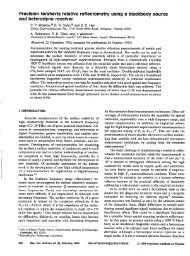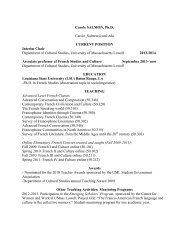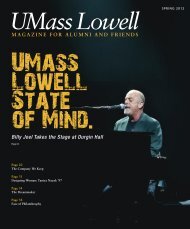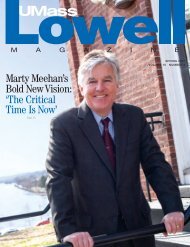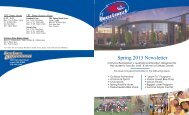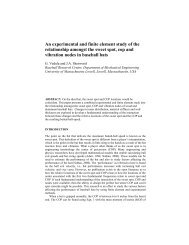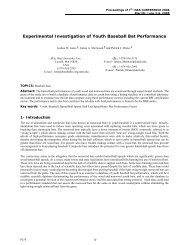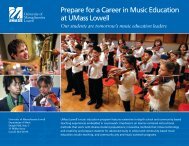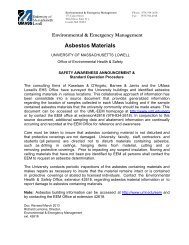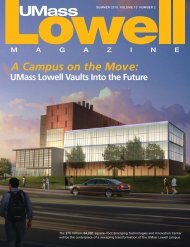comprehensive campus transportation plan - University of ...
comprehensive campus transportation plan - University of ...
comprehensive campus transportation plan - University of ...
You also want an ePaper? Increase the reach of your titles
YUMPU automatically turns print PDFs into web optimized ePapers that Google loves.
<strong>University</strong> <strong>of</strong> Massachusetts Lowell Campus Transportation Plan<br />
III. Existing Conditions Analysis & Key Findings<br />
Extensive demographic, traffic, parking, pedestrian and bicycle data were<br />
assembled as part <strong>of</strong> this study, including up-dated traffic counts, to use as<br />
a basis for understanding the existing conditions at UMass Lowell. Analyses<br />
were performed to understand how people travel to and around the<br />
<strong>campus</strong>es, and what the current infrastructure constraints and<br />
management challenges are. Detailed information on the data and<br />
analyses are included in the Appendix.<br />
While the <strong>transportation</strong> needs for commuting are very different than for<br />
inter-<strong>campus</strong> movement, they both rely heavily on the roadway<br />
infrastructure around and between the <strong>campus</strong>es. Traffic operations in the<br />
City <strong>of</strong> Lowell, therefore, impact UMass Lowell faculty, staff and students<br />
whether they are arriving at or departing from parking lots as part <strong>of</strong> their<br />
daily commute, or are travelling between <strong>campus</strong>es using the UMass Lowell<br />
shuttle bus. Accordingly, traffic congestion is as much <strong>of</strong> an issue for the<br />
UMass Lowell population as it is for the general public. Bicycle and<br />
pedestrians also depend on this roadway infrastructure.<br />
The analysis <strong>of</strong> existing traffic conditions was checked for consistency with<br />
observations in the field, and with reports <strong>of</strong> actual experience from the<br />
UMass Lowell population and City <strong>of</strong> Lowell staff . The data quantified the<br />
extent <strong>of</strong> roadway congestion that prevails during the peak traffic periods in<br />
the morning and evening, typical in an urban environment. It is noticeable,<br />
however, that there is an extended evening peak period in Lowell, with<br />
traffic activity ramping up from as early as 3 PM, when the public schools<br />
are dismissed, until after 6 PM when the concentration <strong>of</strong> commuter traffic,<br />
including UMass Lowell commuters, dies down.<br />
Riverside Street just north <strong>of</strong> <strong>University</strong> Avenue<br />
Figure 5 presents a snapshot <strong>of</strong> peak hour traffic conditions, summarizing<br />
the vehicle level-<strong>of</strong>-service (VLOS) at the 16 key intersections analyzed in<br />
the study. VLOS is a grading <strong>of</strong> the average delay experienced by all<br />
vehicles passing through the intersection, with LOS A representing the<br />
shortest delays and LOS F representing the longest delays. In general, a<br />
VLOS D or better is considered to be an acceptable condition in an urban<br />
situation. It should be noted, however, that at signalized intersections the<br />
VLOS and associated delay is reported as an average for all vehicles using<br />
the intersection, whereas at un-signalized intersections the VLOS is<br />
reported for the critical movement (typically a left-turn from the side-street<br />
across two-way traffic). Accordingly, a favorable VLOS at a signalized<br />
intersection may in fact include a failing VLOS for a particular approach or<br />
movement. A failing VLOS at an unsignalized intersection is for the side<br />
Vanasse Hangen Brustlin, Inc.<br />
9



